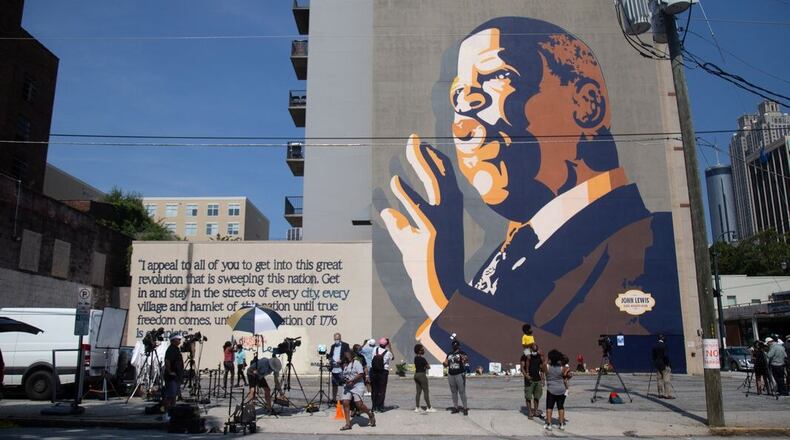In the final year of his life, Congressman John Lewis worked with editor Gretchen Young at Grand Central Publishing on a collection of short, inspirational essays released earlier this month. Released just days before the one-year anniversary of his death, “Carry On” (Grand Central, $22) is designed to inspire future generations with valuable lessons Lewis learned over the course of his storied life, like the one recounted in his essay “On Communication.”
“I moved to Atlanta after college and attended the church where Dr. Martin Luther King Jr. preached,” Lewis writes. “While he was practicing his sermons, his father ― Daddy King ― would sit in the first pew and say, ‘Make it plain. Make it clear. Make it real.’ And Dr. King would do just that, using clear and simple language to communicate his message.”
That same “clear and simple language” is reflected in this book spanning dozens of topics near and dear to Lewis’ heart. There are essays about universal subjects such as faith, fear, courage, love and humility. There are essays about everyday concerns like dress, money, sports and art. And there are essays about hot-button current issues like COVID-19, immigration, environment and health care.
Woven throughout are personal recollections from Lewis’ life and career that run the gamut from the profound to the personal. In “On Death” he recalls what it was like to believe he might die on the Edmund Pettus Bridge when he was severely beaten during the Selma to Montgomery March in 1965. In “On Happiness” he reveals that his definition of contentment was “being at home after a long day, playing with and feeding my cats.”
In “On Mentors,” he writes about the importance of finding a mentor but also the importance of being a mentor. In “On Orientation,” he takes partial responsibility for denying Bayard Rustin, whom Lewis calls “one of the best intellects of the movement” and the person who organized the March on Washington, the right to be chairman of the march because he was gay. But by the end of his life, Lewis believed “you should be free to love whomever you want. … And nobody should be the victim of discrimination on account of sexual orientation.”
The essays in “Carry On” came from conversations Lewis had with Young, who prompted him with questions about his life and philosophy.
“His responses were unadorned, impromptu statements, which he delivered with both conviction and a serene straightforwardness that were quintessential John Lewis,” said Young. “The Congressman wanted the work of making a more just society to continue after he was gone, and he hoped the book would help guide and inspire others to follow in his path. It was his gift to the world as he was leaving it.”
In his essay “On Books,” Lewis expresses his appreciation for comic books, citing how important the 1957 comic “Martin Luther King and the Montgomery Story” was to the civil rights movement. He also mentions how proud he was of the work he did on “March,” the graphic memoir trilogy he penned with Andrew Aydin, featuring illustrations by Nate Powell. It won the National Book Award in 2016.
The sequel to “March” comes out Aug. 3. “Run: Book One” (Abrams ComicArts, $24.99) features the same creative team with the addition of illustrator L. Fury.
Picking up where “March” left off, “Run: Book One” begins after the passage of the Voting Rights Bill in summer 1965 and spans one year to the summer of 1966 when Lewis was forced out of the Student Nonviolent Coordination Committee (SNCC) after three years as its chairman.
It is a powerful account of a pivotal moment in the civil rights movement that saw divisive infighting among the leadership of SNCC, increased visibility of the Ku Klux Klan and an attempt by the Georgia General Assembly to disavow Julian Bond’s election to the state legislature – twice.
The artful combination of text and images paints a harrowing picture of the violence that continued to rock the movement. The killing of 26-year-old seminary student Jonathan Daniels by a deputy in Hayneville, Alabama, is conveyed with a sober illustration. The entire page is mostly black except for the faint gray image of a smoking shotgun on the extreme left side of the page. Equally effective is the jumble of small, sharp-cornered panels filled with angry faces and a fist on a knee to capture the heated debate at the SNCC conference that ousted Lewis.
At the heart of “Run: Book One” is SNCC’s shift away from nonviolence and toward a Black separatist philosophy that was at odds with Lewis, who never wavered from his belief in peaceful protest.
The book ends on a heartbreaking cliffhanger. A full-page illustration provides a bird’s-eye view of Lewis walking out the door of SNCC carrying a mail bin of his meager possessions. The text says: “I was 26 years old … I was broke … I had no job … For my entire adult life, the movement had been my family. I had no wife … No children … No place to even call home anymore.”
Lucky for us, we know better things are in store.
Suzanne Van Atten is a book critic and contributing editor to the Atlanta Journal Constitution. Contact her at svanatten@ajc.com. Follow her on Twitter at @svanatten.
About the Author
The Latest
Featured




